Can this Delaware-invented beehive help save bee colonies from dying?
- Oops!Something went wrong.Please try again later.
Honey is sweet, sure. But bees are a sweaty job.
Keeping a hive is labor of love, with an emphasis on labor. It’s been this way for 170 years, ever since a Philadelphia minister named L.L. Langstroth invented the modern movable-frame hive in 1852.
Every week or two, over and over, you might need to unstack and restack towers of 50-pound, honey-filled boxes as high as your head in order to inspect the queens at the bottom of each hive. You must do this in bee netting, while swarmed by bees in sometimes sticky heat.
It’s hard work, and for more than a century beekeepers have looked for a better way. For just as long, they’ve mostly failed to catch on. Beekeepers are storied cynics, mistrustful of any promised “innovation” over their trusty Langstroth hives.
A pair of Delaware and Pennsylvania beekeepers, including the beekeeper at northern Delaware's storied Winterthur estate, believe they may have finally succeeded in building a better beehive — one that might have a chance at truly changing the way beekeepers manage their hives.
Beekeepers George Datto and Nat Wolfe are calling their invention "The Keeper's Hive," and their designs are already in use around the region, including at the Winterthur estate in Delaware, the SIW Vegetables garden in Chadds Ford and the Brewerytown Garden in Philadelphia.
An online startup campaign has racked up $50,000 in funding and pre-orders over just a couple of weeks, and the hive has garnered international interest.
Why? Datto and Wolfe believe they've finally found a way to take some of the labor out of the avocation they love.
The Keeper's Hive began as a dare
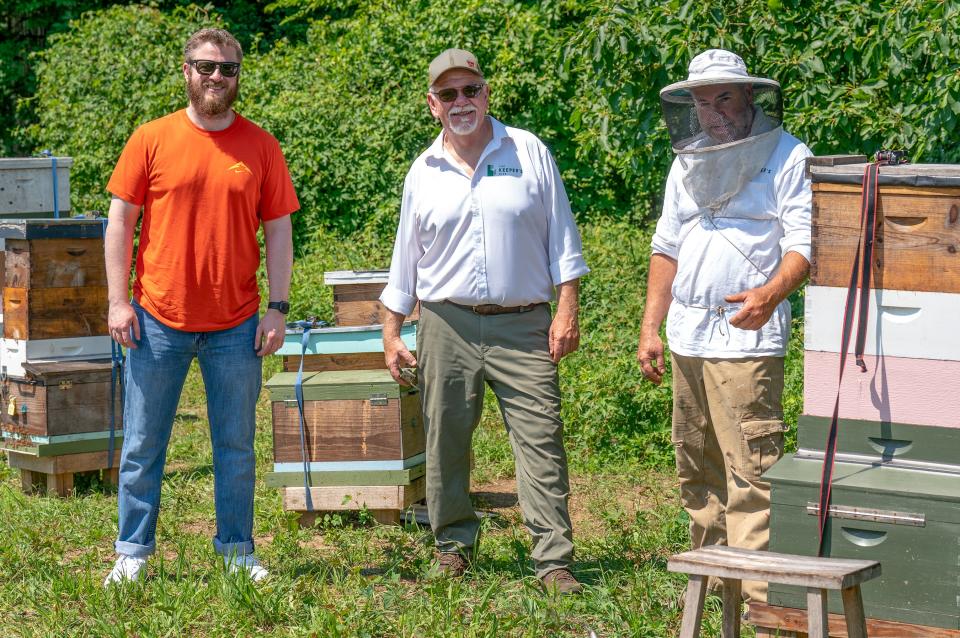
The story began in 2016, on another of northern Delaware's historic estates, where Datto had been keeping bees before he arrived at Winterthur while still keeping his day job as a pediatrician.
Nat Wolfe, a master carpenter on that estate, took an interest in the beehives Datto was keeping there. But he couldn't believe how much senseless work was involved in lifting all those boxes. Finally, he turned to Datto in exasperation.
“George, are you kidding me?" Wolfe remembers exclaiming. "There’s got to be a better way."
Datto responded with a dare.
“If you can come up with something better,” he told Wolfe, “go for it.”
Wolfe went for it. He went home and puttered around, and finally came back to tell Datto it might be a good idea if he stopped by Wolfe's workshop.
When he saw the prototype that Wolfe had hammered together, Datto was gobsmacked: Wolfe's idea could potentially remove the need to move around all those bee boxes. The pair spent years refining the idea, bolstered by Wolfe's carpentry acumen and Datto’s long bee expertise.
The result of all that work, finally, is The Keeper’s Hive, a company based in Datto's home of Glen Mills, Pennsylvania, where he also runs a honey brand called Revolution Bees and heads the local beekeeping association.
A "better beehive" came from a simple idea
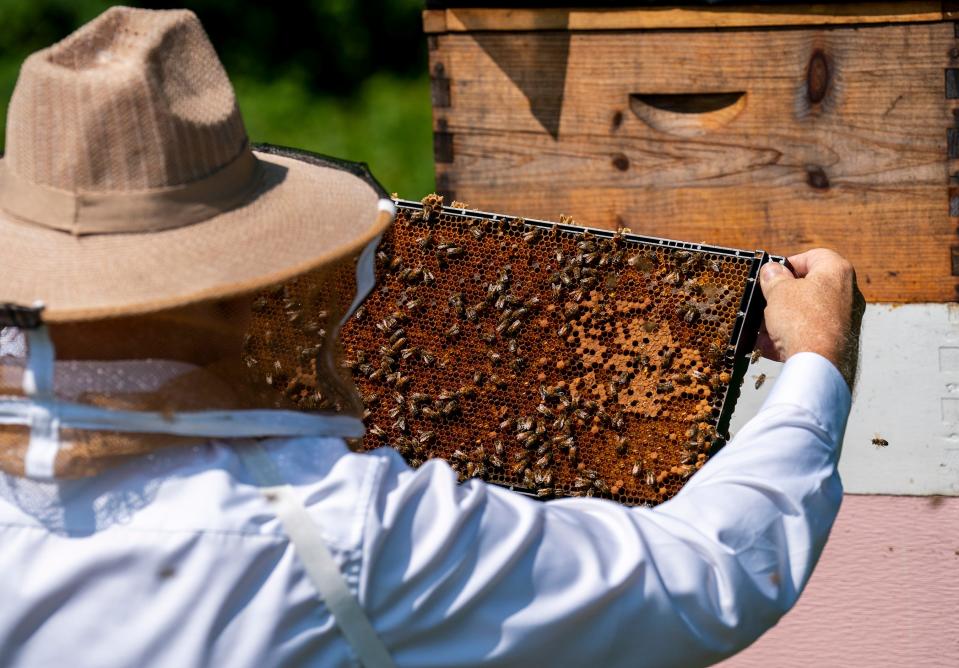
Like most good ideas, the idea behind The Keeper's Hive is quite simple.
Indeed, a key feature is that the design doesn’t change the classic Langstroth hive much at all. Beekeepers can still keep on using the same old Langstroth honey-boxes they already own, making the new hive design much easier to adopt.
"Langstroth is awesome," Datto said. "We just built a better base."
The innovation that led to The Keeper's Hive is all about the beehive's bottom box, the lower sanctum that houses the queen.
For the sake of argument, think of a beehive as a big hanging file cabinet, except the "files" are vertical removable wood-frames that that bees fill with honeycomb. The frames in the hive's top boxes are where worker bees "file" their honey. The bottom cabinet, the brood box, is where the queen lays her eggs.
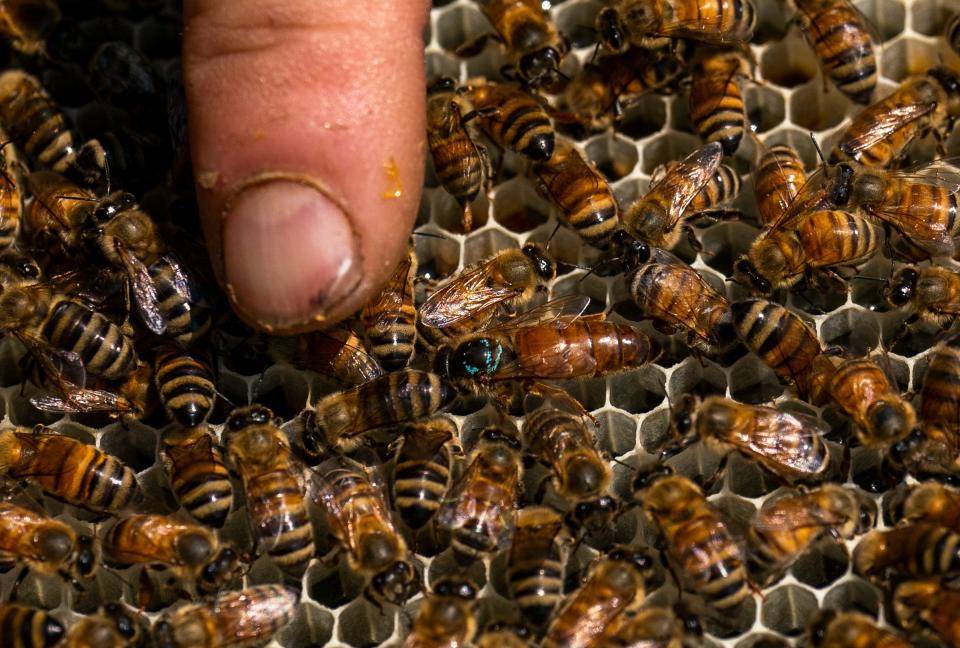
Datto and Wolfe's innovation involves letting those hanging frames on the bottom box slide along little runners, and be removed through a door in the front. Beekeepers can open the door and slide the frames forward to pull them out, without the need of unstacking the boxes on top.
Other beekeepers have thought of sliding brood frames before, of course. But there's always the same problem: Bees are prodigious gluers, and they’ll glue shut almost anything they can get to.
Bees like to hang in spaces three-eighths of an inch across, the "Goldilocks" distance between honeycomb frames. Make the space between frames a bit bigger, and the bees start building honeycombs between the frames. Much narrower, and the bees will gunk up the gaps with a sticky substance called propolis, otherwise known as “bee glue."
Wolfe and Datto managed to solve the bee-glue problem using a few bits of clever carpentry, as well as a pair of removable brackets that close the gaps so bees can't get in to glue up the frames and runners.
Will a new hive design help bees survive?
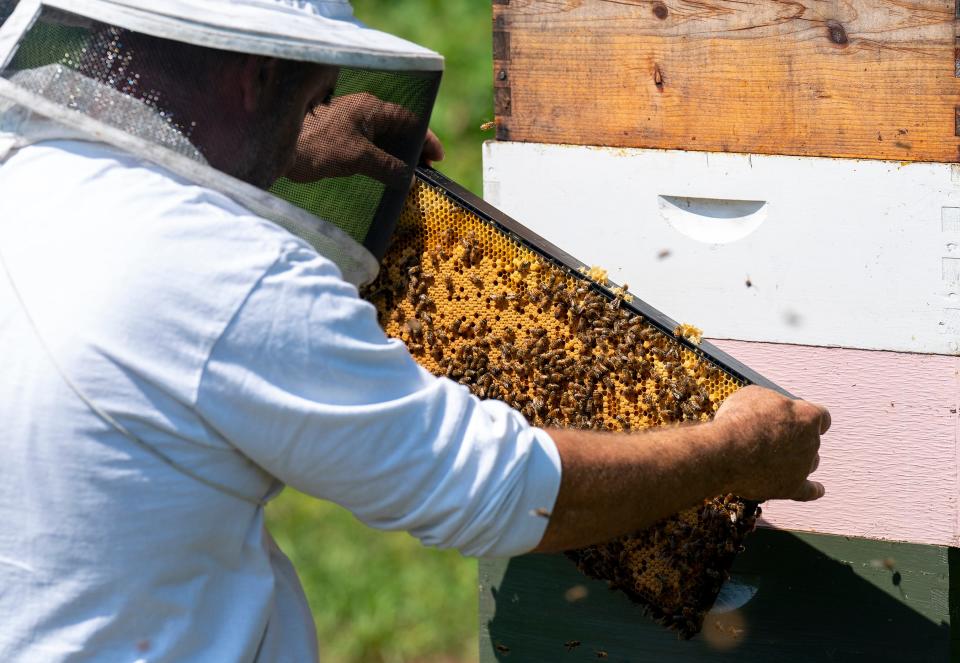
Lowering the effort of beekeeping could have big results for the survival of bees, Datto believes.
Quite simply, Datto said, it’s human nature to be lazy. And where bees are concerned, laziness is dangerous.
Hives have many enemies, from mites to beetles to disease. If a hive is overcrowded, it may swarm. If a beekeeper doesn’t catch a problem early, it may be too late. And if it takes an hour of heavy lifting to check on your queens, you might not be as inclined to inspect hives often enough to spot problems, Datto believes.
Failure to assess the state of a hive can have real effects, Datto said. Nearly half of backyard beehives died in the 2022-2023 season, according to a bee lab study last year — an alarming number that is not just expensive for beekeepers, but also potentially worrisome for the plants and crops that depend on bees to reproduce.
"There are too many bees, and too many colonies, that die," Datto said. "Beekeeping is about honey production, but it's also animal husbandry. It's about raising healthy animials that live. You wouldn't want half your cows to die every year."
Ideally, by making it easier to manage beehives, The Keeper's Hive's inventors hope to help more hives survive.
Beekeepers are slow to change, or to try new designs
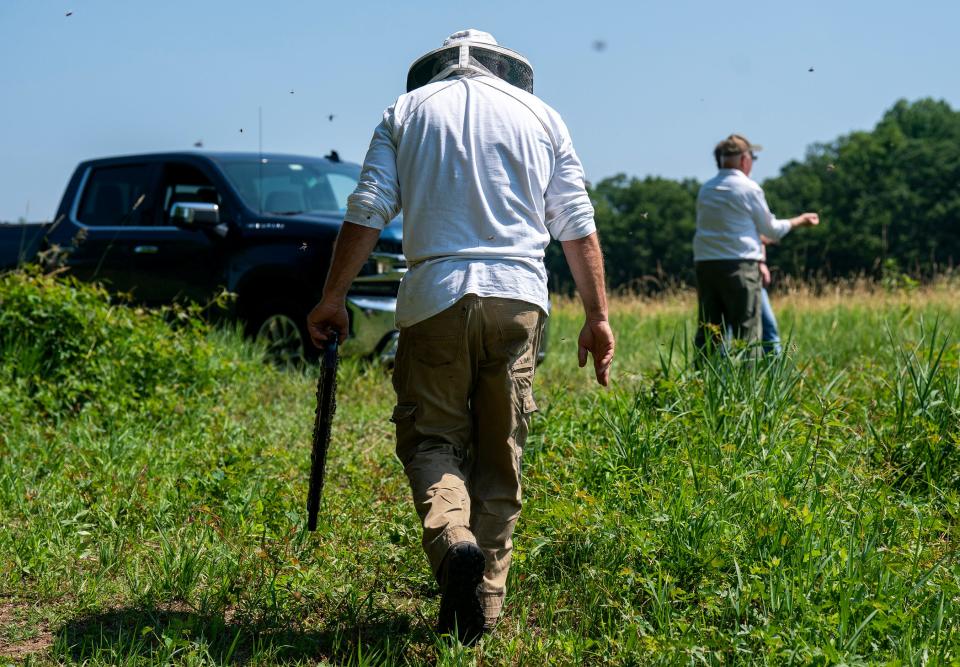
Now the problem was convincing skeptical beekeepers that The Keeper's Hive was anything special.
Datto had a long career behind him in Delaware as a pediatrician, and Wolfe was a skilled carpenter. But neither had any particular experience in marketing or launching a retail business. And when the pair took their hive to beekeeping expos, skeptical beekeepers were a tough audience.
"We'd go to these different shows and we'd set our stuff out on the table, and you'd get hundreds of people walking by in a day," Wolfe said. "They'd see our banner up that said 'Langstroth Without the Lift,' and they'd say 'I'd like to see that!' And then they'd keep on walking."
When the pair demonstrated the hive, things went well. But it was hard to convince people they didn't know to even listen.
That’s where an old childhood friend of Wolfe's son came into play. Dave McNeeley, a Middletown native who’d gone off to run logistics for a high-end photobooth company in New York City before getting into marketing and branding, kept asking Wolfe about the bee invention he’d heard about.
McNeeley kept on asking about the hive, until finally he ended up a partner in the business. Now in Philadelphia, he worked with the pair to figure out a business plan and launch the business nationally.
McNeeley also got hives into the hands of people who might be able to spread the word, including an influential beekeeper in Wales named Laurence Edwards, whose honey brand Black Mountain Honey is known to beekeepers all over the world, in part through a popular YouTube channel.
In a video from May, Edwards tried out the Keeper's Hive after transferring a colony of somewhat perturbed bees, waxing increasingly ecstatic over a hive idea that could save hours and hours of effort.
"This is the Keeper's Hive, and this is probably going to be my favorite video of 2024," Edwards declared, his excitement visible through bee netting.
He then declared the Delaware invention "the coolest beehive I think I have ever seen in my life."
Still, Datto and Wolfe know not to get their hopes up that their invention will immediately take over the world. Afer all, beekeepers are notoriously tough to convince.
In front of his hives at Winterthur, Datto told the story of L.L. Langstroth, the inventor of the modern movable-frame hive. Though now revered as the "father of modern beekeeping," Langstroth famously died a pauper.
Datto and Wolfe can only hope The Keeper's Hive won't take quite as long to catch on.
Matthew Korfhage is business and development reporter in the Delaware region covering all things related to land and money: openings and closings, construction, and the many corporations who call the First State home. Send tips and insults to mkorfhage@gannett.com.
This article originally appeared on Delaware News Journal: Have Delaware, Pennyslvania beekeepers invented a better beehive?

